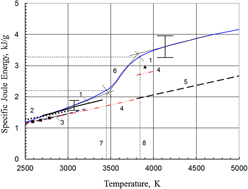Crossref Citations
This article has been cited by the following publications. This list is generated based on data provided by
Crossref.
Savvatimskiy, A I
Onufriev, S V
Muboyadzhyan, S A
and
Seredkin, N N
2017.
Experimental study of high-temperature properties of zirconium carbide as a protective material for nuclear power and aerospace technologies (from 2000 to 5000 K).
Journal of Physics: Conference Series,
Vol. 891,
Issue. ,
p.
012318.
Savvatimskiy, A. I.
Onufriev, S. V.
Muboyajan, S. A.
and
Tsygankov, P. A.
2018.
Pulsed Heating of Carbides.
Bulletin of the Russian Academy of Sciences: Physics,
Vol. 82,
Issue. 4,
p.
363.
Onufriev, S. V.
and
Savvatimskiy, A. I.
2018.
Measuring the Specific Heat of Conducting Substances in Conditions of Microsecond Heating with a Current Pulse.
High Temperature,
Vol. 56,
Issue. 5,
p.
678.
Onufriev, S. V.
2018.
Measuring the Temperature of Substances upon Fast Heating with a Current Pulse.
Bulletin of the Russian Academy of Sciences: Physics,
Vol. 82,
Issue. 4,
p.
372.
Mellan, Thomas A.
Duff, Andrew I.
and
Finnis, Michael W.
2018.
Spontaneous Frenkel pair formation in zirconium carbide.
Physical Review B,
Vol. 98,
Issue. 17,
Ushakov, Sergey V.
Navrotsky, Alexandra
Hong, Qi-Jun
and
van de Walle, Axel
2019.
Carbides and Nitrides of Zirconium and Hafnium.
Materials,
Vol. 12,
Issue. 17,
p.
2728.
Savvatimskiy, A.I.
Onufriev, S.V.
and
Muboyadzhyan, S.A.
2019.
Thermophysical properties of the most refractory carbide Ta0.8Hf0.2C under high temperatures (2000–5000 K).
Journal of the European Ceramic Society,
Vol. 39,
Issue. 4,
p.
907.
Shabalin, Igor L.
2019.
Ultra-High Temperature Materials II.
p.
423.
Mellan, Thomas A.
Duff, Andrew I.
Grabowski, Blazej
and
Finnis, Michael W.
2019.
Fast anharmonic free energy method with an application to vacancies in ZrC.
Physical Review B,
Vol. 100,
Issue. 2,
Mellan, Thomas A.
Aziz, Alex
Xia, Yi
Grau-Crespo, Ricardo
and
Duff, Andrew I.
2019.
Electron and phonon interactions and transport in the ultrahigh-temperature ceramic ZrC.
Physical Review B,
Vol. 99,
Issue. 9,
Savvatimskiy, A. I.
and
Onufriev, S. V.
2019.
Electrical Resistance of the Most Refractory Carbide Ta0.8Hf0.2C in the Solid and Liquid States (2000–5000 K).
High Temperature,
Vol. 57,
Issue. 1,
p.
140.
Ionescu, Emanuel
Bernard, Samuel
Lucas, Romain
Kroll, Peter
Ushakov, Sergey
Navrotsky, Alexandra
and
Riedel, Ralf
2019.
Polymer‐Derived Ultra‐High Temperature Ceramics (UHTCs) and Related Materials.
Advanced Engineering Materials,
Vol. 21,
Issue. 8,
Savvatimskii, A I
and
Onufriev, S V
2020.
Investigation of the physical properties of carbon under high temperatures (experimental studies).
Physics-Uspekhi,
Vol. 63,
Issue. 10,
p.
1015.
Savvatimskiy, A. I.
Onufriev, S. V.
Valyano, G. E.
and
Muboyadzhyan, S. A.
2020.
Thermophysical properties for hafnium carbide (HfC) versus temperature from 2000 to 5000 K (experiment).
Journal of Materials Science,
Vol. 55,
Issue. 28,
p.
13559.
Aristova, N. M.
Onufriev, S. V.
and
Savvatimskiy, A. I.
2020.
Specific Heat of Liquid Zirconium Carbide ZrC0.95 at Temperatures up to 5000 K.
High Temperature,
Vol. 58,
Issue. 5,
p.
681.
Savvatimskiy, A I
Aristova, NM
Onufriev, S V
and
Valiano, G E
2020.
Specific heat of refractory carbides (ZrC0.95, HfC0.85 and Ta0.8Hf0.2C) in the temperature interval 2500-5000 K.
Journal of Physics: Conference Series,
Vol. 1686,
Issue. 1,
p.
012055.
Savvatimskii, A. I.
and
Onufriev, S. V.
2020.
Resistivity of Refractory Carbides (ZrC, HfC, and TaC + HfC) in the Solid and Liquid States.
High Temperature,
Vol. 58,
Issue. 6,
p.
800.
Pakhomov, E. P.
2020.
Defect Structure of Zirconium Carbide.
Crystallography Reports,
Vol. 65,
Issue. 1,
p.
91.
Aristova, N. M.
2020.
Heat Capacity of Crystalline and Liquid Zirconium Carbide, with a Composition Close to Stoichiometric ZrC0.95–0.99
.
Russian Journal of Physical Chemistry A,
Vol. 94,
Issue. 13,
p.
2685.
Ushakov, Sergey V.
Niessen, Jonas
Quirinale, Dante G.
Prieler, Robert
Navrotsky, Alexandra
and
Telle, Rainer
2021.
Measurements of Density of Liquid Oxides with an Aero-Acoustic Levitator.
Materials,
Vol. 14,
Issue. 4,
p.
822.






